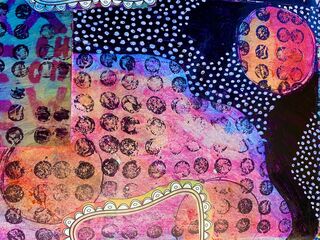
“Effervescent Second in Macau,” visible journal entry by Cathy Malchiodi PhD
Supply: © 2021 Courtesy of Cathy Malchiodi, PhD
In expressive arts therapy classes, we capitalize on 4 phenomena to ascertain attuned relationships—rhythm, motion, entrainment, and synchrony. These experiences are key to supporting experiences of enlivened social engagement and enhancing the neuroception of security with others. In work with traumatized people, I refer to those because the 4 parts essential to bridge the “relational house” (Malchiodi, 2020).
Synchrony and Entrainment
Synchrony and entrainment are notably essential to boost wholesome connection and attachment. Entrainment refers back to the bodily course of by which impartial rhythmical programs work together with one another. Examples of naturally occurring rhythmical programs throughout the human physique embody the heartbeat, blood circulation, respiration, locomotion, and eye blinking. Ladies are accustomed to female-related entrainment experiences that always happen together with secretion of hormones and menstrual cycles. Animals’ rhythmic programs also can entrain us to their rhythms. For instance, it’s well-known amongst equine-assisted practitioners that types of “cardiac coherence” can happen in people within the presence of horses and vice-versa (Scopa, et al, 2020).
Synchrony is commonly confused with the idea of entrainment. Like entrainment, synchrony does contain rhythmic interplay, however the emphasis is on experiences that set up person-to-person bonding. This “interpersonal synchrony” contains rhythmic coordination of actions, feelings, prosody, and even ideas between people. Analysis underscores that the formation of interpersonal synchrony is the essence of reciprocal interactions between infants and their caregivers (Brooks, et al, 2019). Easy types of synchrony embody clapping collectively in rhythm with a baby, laughing along with mates, or nodding in settlement along with your accomplice. We regularly spontaneously regulate our responses to be “in sync” with these round us and, particularly, people with whom we’ve affiliative or pro-social relationships.
In expressive and somatosensory work, we purposively assist synchrony by means of experiences of singing, shifting, or talking collectively. The inherent concord induced by these experiences, of being in a bunch in comparable rhythm and cadence collectively, brings higher emotional closeness and rapport. It’s a type of co-regulation that reinforces a way of security, consolation, and connection (Malchiodi, 2021).
Collective Effervescence
There’s a kind of synchrony that connects people in highly effective and far-reaching methods—it’s referred to as collective effervescence. This idea was first described by Emile Durkheim in Elementary Types of Non secular Life, a examine of religions with a concentrate on rites and rituals. In these occasions, he noticed a vibrant power that flowed by means of communities when collaborating in a ritual collectively. Primarily we merge with the group’s circulate; it’s a shared expertise that always brings about robust emotion and even euphoria. Durkheim believed that the excessive emotional arousal ensuing from this intense type of social sharing empowers us and touches us in deep, usually implicit methods.
The phenomenon of collective effervescence has now been studied for a lot of many years. It’s now clear that it isn’t solely a part of rites and rituals, but in addition happens all through different varieties of shared actions. As Durkheim noticed, it’s a potent and impactful human phenomenon and one which we search to search out. On this present interval of bodily distancing and separation, we crave it a lot we had been generally keen to interrupt guidelines to expertise it. The sense of power and concord we really feel after we come collectively in a bunch round a shared objective will not be solely pushed by particular person want. It’s a homing sign, an inner barometer of well-being and perceived well being.
In researching this put up, I discovered that Emile Durkheim first wrote about collective effervescence a couple of years earlier than the Spanish flu outbreak started, a second in historical past mirrored in current instances. Because the aftermath of that Twentieth-century pandemic waned, what got here to be referred to as the “Roaring Twenties” emerged. In some components of the world, that decade grew to become a time of artistic collaboration, an incredible upsurge within the arts and improvements. As we transfer by means of this present pandemic, I questioned if we are going to see an identical uptick in collaborative output outdoors of Zoom screens or device-driven connecting.
This little bit of historical past is no less than one hopeful thought I’m hanging onto amidst what seems to be yet one more pandemic pivot in the mean time. I’m trying ahead to the following time I can slip into rhythm with others on a dance flooring; to sit down amid fellow artists in artistic collaboration; to be in a dialogue session at knowledgeable convention; and to sing, drum, and strum in the identical room with fellow would-be musicians. Re-sensitizing the physique, particularly after many tough months of immobilization and bodily distancing, is crucial to our collective restoration. And it’s collective effervescence that could be the artistic synchrony many people desperately want.
Source link











